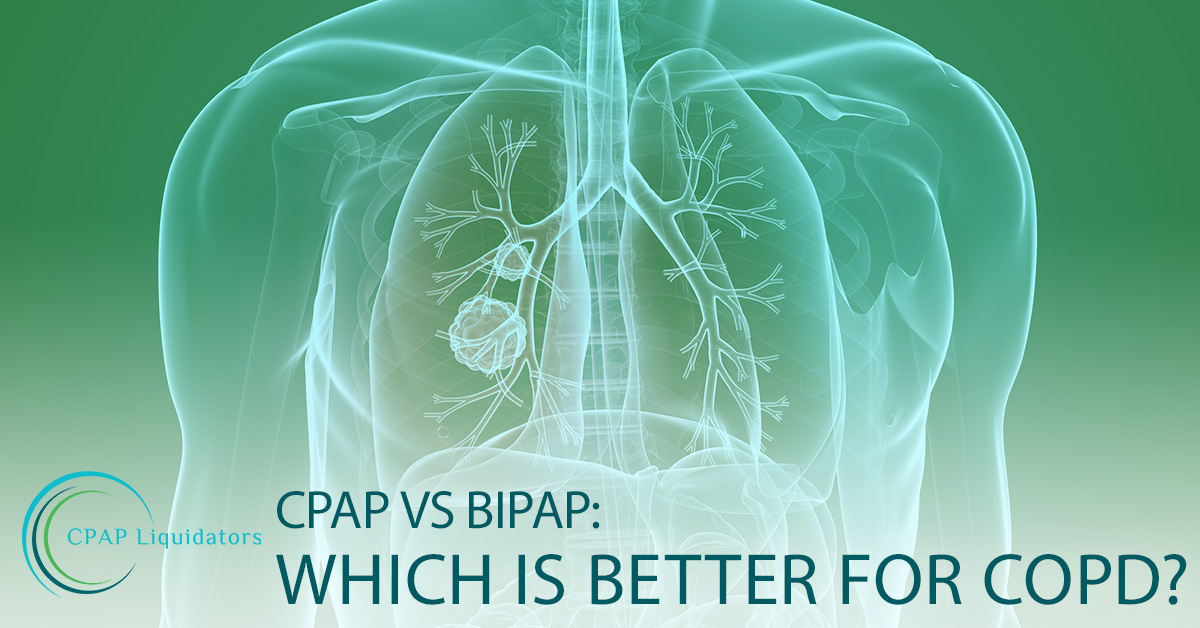Posted by CPAP Liquidators on Jun 25th 2018
CPAP vs BiPAP: Which is Better for COPD?

Sleep is one of the most important parts of our lives. When we don’t get enough sleep, it affects everything we do. From health issues to social struggles and trouble at work, a lack of sleep is a the core of so many problems we encounter daily. When dealing with sleep disorders, your health and well-being is at risk, which makes proper treatment absolutely vital. A lung disorder like COPD can cause a lot of issues for us as we sleep, but there are ways it can be treated. Today, we’re going to take a deeper look at what COPD is, the differences between CPAP and BiPAP therapy, and which one is best to treat it so you can sleep easy through the night. If you’re looking for a new or used CPAP or BiPAP machine, CPAP Liquidators has what you need.
-What is COPD?
Chronic Obstructive Pulmonary Disease is described as a deficiency of airflow through the lungs, often caused by two respiratory diseases: emphysema and chronic bronchitis. This causes people with COPD to struggle to breathe, while not receiving the benefits that are supposed to come with breathing. When we breathe, the oxygen we take in is supposed to enrich our blood and provide fuel for our cells, while exhaling releases carbon dioxide, which is a waste product of our cells. COPD causes permanent damage to the airway tissues, making it far more difficult to handle this exchange of gases. This is due to the lungs losing their elasticity, inhibiting the ability to breathe in and out deeply enough to be effective, which is also referred to as Tidal Volume. This disorder also causes people to overwork their accessory breathing muscles in an attempt to get minimal oxygen. Diseased lungs produce excess mucus, resulting in a lot of coughing. Sufferers of COPD will later develop hypoxemia (chronic low blood oxygen) and hypercapnia (chronic carbon dioxide overload), resulting in a loss of sleep and energy. The issues presented by COPD are further intensified when combined with secondary problems such as hypertension, arrhythmia, or Obstructive Sleep Apnea, making respiratory issues while sleeping much more likely.
-How is it Treated?
Disorders like COPD can be treated by Non-Invasive Ventilation (NIV), which are types of mechanical therapy that do not require equipment to be inserted in the airway, unlike intubation or tracheotomy. The most common form of NIV therapy is implemented with a Positive Airway Pressure (PAP) device. While Continuous Positive Airway Pressure (CPAP) is the most well known, Bi-level Positive Airway Pressure (BiPAP/BPAP) is another form of NIV therapy. While they were both originally developed to treat people with sleep apnea, they can also help improve breathing while sleeping for people with other respiratory disorders.
-Difference Between CPAP and BiPAP
CPAP therapy operates by sending a single preset air pressure to keep the airways open. BiPAP, as you might assume from the name, utilizes two levels of air pressure — IPAP, which corresponds with inhaling, and EPAP, which corresponds with exhaling. BiPAP machines also include a feature which adapts to the user’s respiratory patterns on the fly, resetting at different pressures to keep the breathing rate on target. This helps to relieve overworked breathing muscles.
-Which is Better for COPD?
For people that suffer from Chronic Obstructive Pulmonary Disease, BiPAP therapy has been the most successful form of NIV treatment. This is because the mechanisms involved in BiPAP are more suited to target the dysfunctional breathing patterns of COPD patients. BiPAP’s dual custom air pressures targeting both inhaling and exhaling take the strain of breathing from patients as they sleep, while providing a steady flow of oxygen to enrich the blood. BiPAP is also more efficient at dispersing excess carbon dioxide, which is something that CPAP is unable to do. BiPAP also has the very beneficial ability to adjust the “rise time”, as COPD causes someone to take longer to exhale, while inhaling is very short and quick. Adjusting the rise time function lets the physician to customize the rate of air on inhalation to the needs of the patient. The rise time for a COPD patient will typically be set to provide air upon inhalation faster than what a normal patient would require. The ability to fine tune the BiPAP therapy is key to the success of NIV in a COPD patient.
If you have COPD and want to get back to sleeping normally, there are options available to you. Consult with your doctor to see if they believe you’ll benefit from NIV therapy. When you take control of your health with the right treatment, you can live a long and fruitful life. If your doctor does think you’ll benefit from the use of a BiPAP machine, call CPAP Liquidators to get the ball rolling. We offer many different new and used BiPAP machines, as well as a variety of accessories to ensure you get the most out of your therapy. We’ll be more than happy to help you get the good night’s rest you deserve.
